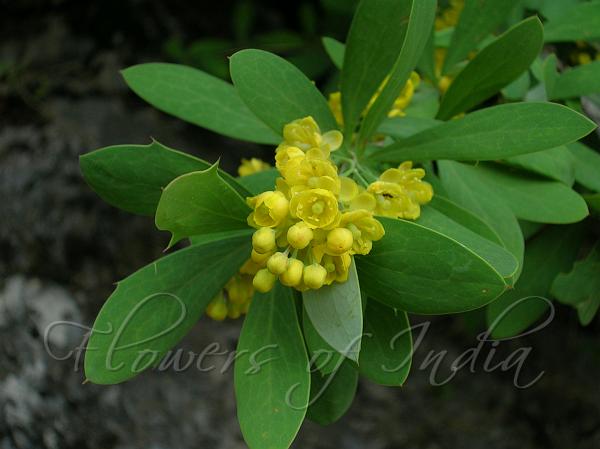|
| Indian Lycium |
|

|

| File size | 1056634 |
| Original date | 4/13/08 4:40 PM |
| Resolution | 2048 x 1536 |
| Flash | Flash did not fire, auto |
| Focal length | 10.5mm |
| Exposure time | 1/67s |
| Aperture | 3.7 |
| Focus Distance | |
| Metering Mode | Partial |
| Camera make | NIKON |
| Camera model | E3700 |
| Sensor type |
|
|
|
|
Photo: |
Botanical name: Berberis lycium Family: Berberidaceae (Barberry family)
Synonyms: Berberis afghanica, Berberis angustifolia, Berberis heteracantha
Synonyms: Berberis afghanica, Berberis angustifolia, Berberis heteracantha
Indian Lycium is a semi deciduous shrub, up to 3-4 m,
with white stems, and narrow fine-pointed leathery leaves mostly without
spiny teeth, glaucous beneath. Flowers are dull yellow, 7-8 mm across, borne
in leaf-axils, in clusters 3-5 cm, longer than the leaves. Leaves are
inverted-lanceshaped, 2-4 cm; stems hairless, stem spines 6-20 mm. Berries are
ellipsoid-ovoid, hairless, greenish first, turning dark purple or
black when ripe, 9-10 mm including the 1 mm style. Indian Lycium is found in
shrubberies; common in cultivated areas of W. Himalaya, from Pakistan to
E Nepal, at altitudes of 1500-3000 m. Flowering: March-June.
Medicinal uses: Indian Lycium's roots are used as remedy for
swollen and sore eyes, broken bones, wounds, gonorrhea, curative piles,
unhealthy ulcers, acute conjunctive and in chronic opthalmia, also used as
bitter tonic astringent, diaphoretic and febrifuge. Leaves are given in
jaundice.
Indian Lycium's roots are used as remedy for
swollen and sore eyes, broken bones, wounds, gonorrhea, curative piles,
unhealthy ulcers, acute conjunctive and in chronic opthalmia, also used as
bitter tonic astringent, diaphoretic and febrifuge. Leaves are given in
jaundice.
Medicinal uses:
 Indian Lycium's roots are used as remedy for
swollen and sore eyes, broken bones, wounds, gonorrhea, curative piles,
unhealthy ulcers, acute conjunctive and in chronic opthalmia, also used as
bitter tonic astringent, diaphoretic and febrifuge. Leaves are given in
jaundice.
Indian Lycium's roots are used as remedy for
swollen and sore eyes, broken bones, wounds, gonorrhea, curative piles,
unhealthy ulcers, acute conjunctive and in chronic opthalmia, also used as
bitter tonic astringent, diaphoretic and febrifuge. Leaves are given in
jaundice. | Identification credit: Nongthombam Ullysess | Photographed in Mussoorie, Uttarakhand & Rajouri, J&K. |
• Is this flower misidentified? If yes,